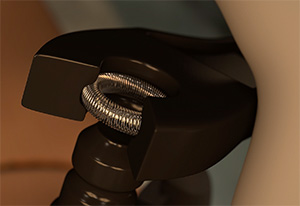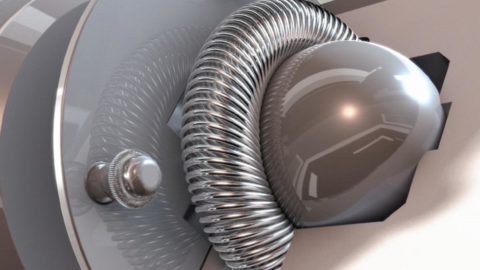A manufacturer of surgical instruments is using Bal Spring® canted coil springs to give doctors new insight into critical spinal procedures.
Massachusetts-based Life Instruments Corp. has designed the springs into its Radiolucent Cervical Retractor. According to the company’s president and CEO, Larry Foley, the springs act as “markers” under x-ray, and allow for the integration of polymer retractor blades that offer improved visibility over traditional stainless steel.
“Standard retractors, which are made completely from stainless, can impede the surgeon’s ability to see critical areas during spinal surgeries,” says Foley. “We wanted to design a blade that would be invisible under x-ray, but we still needed to provide some visual reference for positioning purposes. The canted coil springs allow us to do that.”
During spinal procedures, surgeons use a cervical retractor to spread both the skin and muscles surrounding the spine in order to repair the vertebrae. The instrument is inserted into the skin in the front of the neck, spreading apart the layers of tissue and muscle covering the vertebrae. This crucial step creates the necessary window for a doctor to perform the procedure.
According to Foley, Life Instruments chose to form the blades of its retractor from polyether ether ketone (PEEK), an organic polymer thermoplastic approved by the FDA for use in the human body for surgery and medical implants. The material, he says, offered the ideal combination of strength and radiolucency. But without some kind of visual reference, the design wasn’t complete.

In its quest to provide this important advantage, Foley’s company sought assistance from Bal Seal Engineering, a Foothill Ranch, Calif.-based manufacturer of custom-engineered sealing, connecting, conducting and shielding solutions for medical devices. Engineers from both companies determined that Bal Spring® canted coil springs, positioned inside grooves in the retractor blades, could serve as snap-connector components while providing circular referencing “footprints” for guidance under x-ray.
The Life Instruments engineers who worked on the retractor product say the springs offer users other benefits beyond better visibility.
“The fact that we specified springs made from MP35N®, which is a robust, medical-grade material, means they’re steam sterilization-autoclavable to 15 PSI at 220° F,” one engineer confirmed. “As a connector component, they also afford us flexibility. The retractor has interchangeable blades that range in size from 30mm to 65mm, and the springs allow a user to switch them with just three pounds of insertion and removal force.”
Life Instruments currently sells its radiolucent retractor in a kit configuration with an autoclavable storage tray. The company says the instrument is popular among surgeons who perform image-dependent spinal procedures.










